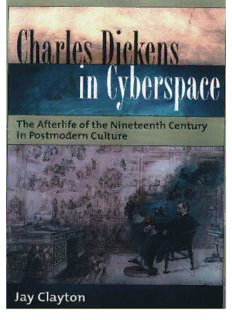
Charles Dickens in Cyberspace: The Afterlife of the Nineteenth Century in Postmodern Culture PDF
Preview Charles Dickens in Cyberspace: The Afterlife of the Nineteenth Century in Postmodern Culture
CHARLES DICKENS IN CYBERSPACE This page intentionally left blank Jay Clayton Charles Dickens I N C Y B E R S PA C E The Afterlife of the Nineteenth Century in Postmodern Culture 1 2003 3 Oxford New York Auckland Bangkok Buenos Aires Cape Town Chennai Dar es Salaam Delhi Hong Kong Istanbul Karachi Kolkata Kuala Lumpur Madrid Melbourne Mexico City Mumbai Nairobi São Paulo Shanghai Taipei Tokyo Toronto Copyright © by Oxford University Press,Inc. Published by Oxford University Press,Inc. Madison Avenue,New York,New York, www.oup.com Oxford is a registered trademark ofOxford University Press All rights reserved.No part ofthis publication may be reproduced, stored in a retrieval system,or transmitted,in any form or by any means, electronic,mechanical,photocopying,recording,or otherwise, without the prior permission ofOxford University Press. Library ofCongress Cataloging-in-Publication Data Clayton,Jay,– Charles Dickens in cyberspace :the afterlife ofthe nineteenth century in postmodern culture / Jay Clayton p. cm. Includes bibliographical references and index. ISBN --- .English literature—th century—History and criticism—Theory, etc. .Dickens,Charles,–—Appreciation—United States. .Criticism—United States—History—th century. .English literature— Appreciation—United States. .United States—Civilization—British influences. .United States—Civilization—th century. .Great Britain—Civilization— th century. .Postmodernism (Literature)—United States. .Literature and science—United States. .Literature and science—Great Britain. .Romanticism—Great Britain. I.Title. PR. C (cid:2).—dc Printed in the United States ofAmerica on acid-free paper TO JIM AND JOHN This page intentionally left blank ACKNOWLEDGMENTS I am grateful to the numerous people who have helped me by suggesting sources and responding to questions: Joseph Bizup, Christy Burns, Janice Carlisle,Margaret Darby,Lynn Enterline,Eileen Gillooly,Gregg Hecimovich, Kurt Koenigsberger,Laurence Lerner,Alan Liu,Robert O’Malley,Leah Mar- cus, Jaya Mehta, Eric Rothstein, Garrett Stewart, Ronald Thomas, Cecelia Tichi,and Joseph Witek.My colleagues at Vanderbilt University were enor- mously supportive,particularly a group ofunselfish friends who read por- tions ofthis manuscript at crucial stages:Jerry Christensen,Carolyn Dever, Jim Epstein,Deak Nabers,Mark Schoenfield,and Mark Wollaeger.Others who have guided me with their clear-sighted responses include Alison Booth, Marianne Hirsch, Margaret Homans, Andrew Miller, Dianne F. Sadoff, Valerie Traub,and Priscilla Wald.Several friends in Nashville and elsewhere have stimulated me by their wide-ranging engagement with literature,sci- ence, and society: George Bradley, Robert J. Coffey, Marie Griffin, Keith Meador,and Craig Smyser. Lisa Niles has been an exemplary research assistant,as knowledgeable as she is professional.Jamie Adams,who took the photos reproduced here,was a pleasure to work with.Elissa Morris,my editor at Oxford University Press, encouraged this project and helped shape it in valuable ways.Barry Varela suggested several points during the editing process. viii acknowledgments I would also like to thank the John Simon Guggenheim Memorial Foun- dation and Vanderbilt University for fellowships that gave me time to work on this study.Audiences at a number ofinstitutions have provided me with valuable responses to early versions ofthis material:The Center for Aesthet- icsand Logic at Aalborg University,Denmark;Cornell University;CUNY— Graduate Center; Emory University; The English Institute; INCS—Inter- disciplinary Nineteenth-Century Studies;Indiana University;The Modern Language Association; The Society for the Study of Narrative Literature; The National Human Genome Research Institute;The Northeast Victorian Studies Association; The Society for Literature and Science; Southern Methodist University; Tulane University; Vanderbilt Medical School; and The University ofWashington. Finally,I give thanks to Ellen Wright Clayton,companion in the pleas- ures ofscholarship as in all other things,and to our two children,who have waited long to have this work dedicated to them.Now that it has arrived,it cannot possibly express all they have meant to me. Portions ofvarious chapters appeared,in altered form,in the following places and are reprinted with the permission oftheir publishers:“Dickens and the Genealogy ofPostmodernism,”Nineteenth-Century Literature():– ;“Is Pip Postmodern? or,Dickens at the End ofthe Twentieth Century,”Case Studies in Contemporary Criticism: Charles Dickens’s “Great Expectations”, ed.Janice Carlisle (Boston:Bedford Books,),pp.–;“Concealed Circuits:Frankenstein’s Monster,the Medusa,and the Cyborg,”Raritan ():–;“The Voice in the Machine:Hazlitt,Hardy,James,”Language Machines: Technologies ofLiterary and Cultural Production,ed.Jeffrey Mas- ten, Peter Stallybrass, and Nancy J. Vickers (New York: Routledge, ), pp.–;“Hacking the Nineteenth Century,”Victorian Afterlife: Postmod- ern Culture Rewrites the Nineteenth Century,ed.John R.Kucich and Dianne F.Sadoff(Minneapolis:University ofMinnesota Press,),pp.–; “Genome Time,”Time and the Literary,ed.Karen Newman,Jay Clayton,and Marianne Hirsch (New York:Routledge,),pp.–;“Cultural Patch- work in the Classroom: Shelley Jackson, Tom Stoppard, William Gibson, and Bruce Sterling Rewrite the Romantics,”Romanticism and Contemporary Culture,online,http://www.rc.umd.edu/features/rcc/papers.html,February ;“Frankenstein’s Futurity:From Replicants to Robotics,”The Cambridge Companion to Mary Shelley,ed.Esther Schor (Cambridge:Cambridge Uni- versity Press,),pp.–;and “Convergence ofthe Two Cultures:A Geek’s Guide to Contemporary Literature,”American Literature():–. Classics Illustratedcovers of Great Expectations(and ).Copy- right © , Classics International Entertainment,Inc.All rights re- served.Classics Illustrated® is a registered trademark of Frawley Corpora- tion. Classics International Entertainment™ is a trademark of Classics International Entertainment,Inc., North Michigan Avenue,th Floor, Chicago,IL . CONTENTS Introduction Dickens Browses the World Wide Web One The Past in the Future ofCultural Studies Crystal Palace to Millennium Dome Two The Voice in the Machine Hazlitt,Austen,Hardy,and James Three Undisciplined Cultures Peacock,Mary Somerville,and Mr.Pickwick Four Hacking the Nineteenth Century Babbage and Lovelace in The Difference Engine and Arcadia Five Concealed Circuits Frankenstein’s Monster,Replicants,and Cyborgs Six Is Pip Postmodern? Or, Dickens at the Turn ofthe Millennium Seven Genome Time New Age Evolution,The Gold Bug Variations, and Gattaca
Description: